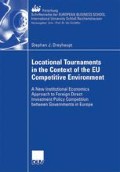Abstract
Europe as a region presents itself as a formidable candidate for the study of FDI competition. First of all, Europe is the most dynamic region in terms of FDI activity, both as a host as well as home destination to global FDI flows. Second, the European FDI competition framework is arguably the most comprehensive and sophisticated in the world, and sufficiently long established to draw preliminary conclusions about its effectiveness. Third, the current and future process of EU enlargement enhances the study by adding a dynamic element due to the ongoing harmonization efforts between old and new member countries. This chapter will examine the first two issues in detail, setting the stage for the discussion of the third issue in Chapter 4.
Access this chapter
Tax calculation will be finalised at checkout
Purchases are for personal use only
Preview
Unable to display preview. Download preview PDF.
References
See UNCTAD (2003). In addition to inflows to the European Union (US$374,380 million) this includes inflows into Other Western Europe (US$10,011 million) and Central and Eastern Europe (US$28,709 million). See Annex Table A-5 for details.
See UNCTAD (2003). In addition to outflows from the European Union (US$ 394,146 million) this includes outflows from Other Western Europe (US$17,519 million) and Central and Eastern Europe (US $4,205 million). See Annex Table A-7 for details.
Although Luxemburg/ Belgium is technically the world’s largest inward and outward investor these flows consist mostly of transshipped investment, i.e., large matching in-and outflows through holding companies and other special purpose entities located in this country. The example serves as a reminder that aggregate statistics need to be interpreted with due diligence (see also UNCTAD, 2003, p. 69).
The largest decline is predicted to be in Germany (down 64 percent), the UK (down almost 50 percent), the Nordic countries and CEE (Slovakia and the Czech Republic down 85 and 70 percent respectively). See OECD (2004) for details on this forecast.
Investment from the EU accounted for 95 percent of FDI in Poland in 2000, 80 percent in the Czech Republic, and 80 percent in Estonia as well (see LOVINO, 2002, p. 5).
See UNCTAD (2003a), p. 2.
See KOJIMA (2000) for details on this phenomenon of industrial upgrading, which has been termed “Flying Geese”-Paradigm.
See EU (2002), p. 77.
See OECD (2000), p. 9. For details on FDI inflows into Central and Eastern Europe by sector in 1999, as percentage of FDI Inward Stock, see Annex Table A-11.
See also UNCTAD (2003a) p. 4 which reports the share of the tertiary sector in the Czech Republic at 57 percent, in Poland at 77 percent and in Hungary at 61 percent in 2000.
According to the OLI Paradigm, FDI flows in the manufacturing sector have traditionally been motivated by resource-, efficiency-or market-seeking goals. See OECD (2004) for further discussion.
See OECD (2004), p. 10.
Hungary has seen some of this kind of restructuring when Flextronics, Philips and IBM undertook both relocations (footwear, automotive, electronics) and expansions (electronics — different segment, corporate services, automotive and other production) in 2002/ 2003 (see UNCTAD, 2003, pp. 62–63).
See UNCTAD (2003); RAINES/ BROWN (1999).
For example, the Intel case detailed in SPAR (1998) illustrates the company’s global search for suitable production facilities in China, India, Indonesia, Singapore, Thailand and Latin America. See also UNCTAD (2003), p. 124.
See HEATH (2001), p. 722.
See OMAN (2000), p. 80.
In the United States, for example, Amarillo County, Texas offers any investor who creates more than 700 jobs an upfront grant of US$ 8 million. By comparison, some counties in New Hampshire offer no incentives at all (see OLIVIER, 2002).
See, for example, UNCTAD (1996); OMAN (2000); WELLS/WINT (2000); CHARLTON (2003); UNCTAD (2003).
See UNCTAD (1996), pp. 29–30.
OMAN (2000), p. 77.
See WELLS/ WINT (2000), p. 4.
UNCTAD (2004), p. 1.
See UNCTAD (2001), p. 38.
See UNCTAD (2001), p. 18.
See WELLS/ WINT (2000), p. 32.
See EASSON (2001), pp. 271–272.
See OMAN (200), p. 115.
Rights and permissions
Copyright information
© 2006 Deutscher Universitäts-Verlag | GWV Fachverlage GmbH, Wiesbaden
About this chapter
Cite this chapter
(2006). European FDI Competition in Perspective. In: Locational Tournaments in the Context of the EU Competitive Environment. DUV. https://doi.org/10.1007/978-3-8350-9109-2_7
Download citation
DOI: https://doi.org/10.1007/978-3-8350-9109-2_7
Publisher Name: DUV
Print ISBN: 978-3-8350-0280-7
Online ISBN: 978-3-8350-9109-2
eBook Packages: Business and EconomicsEconomics and Finance (R0)

